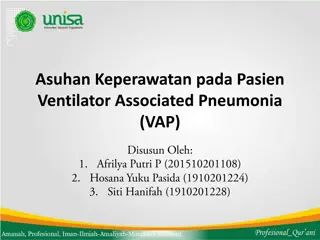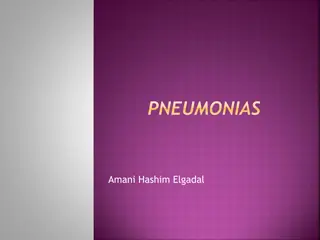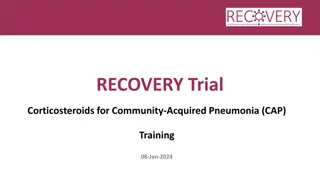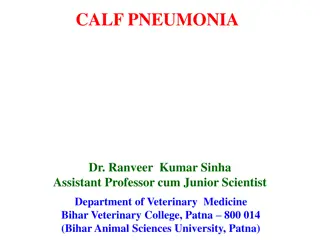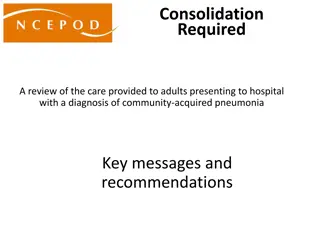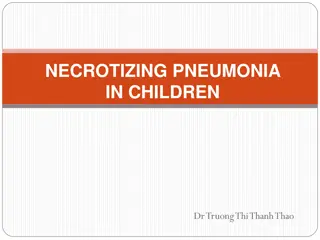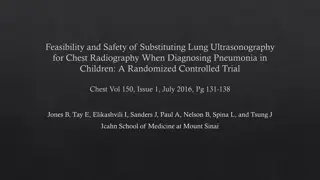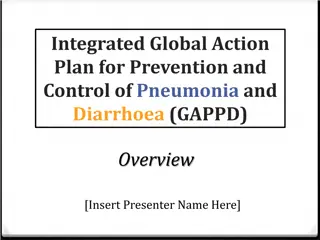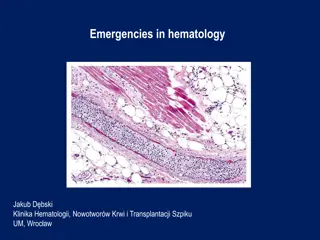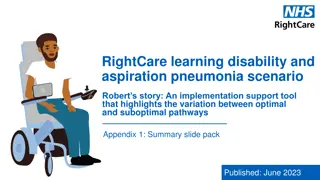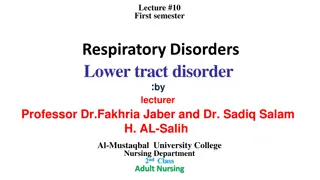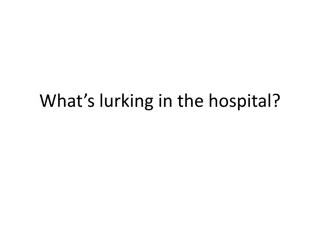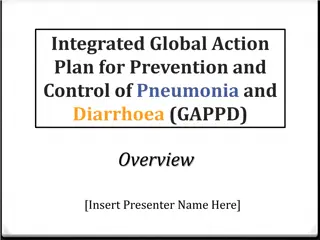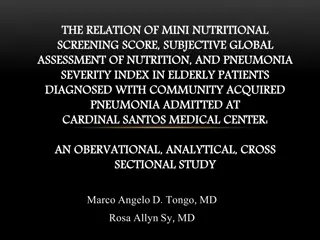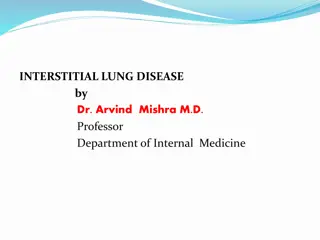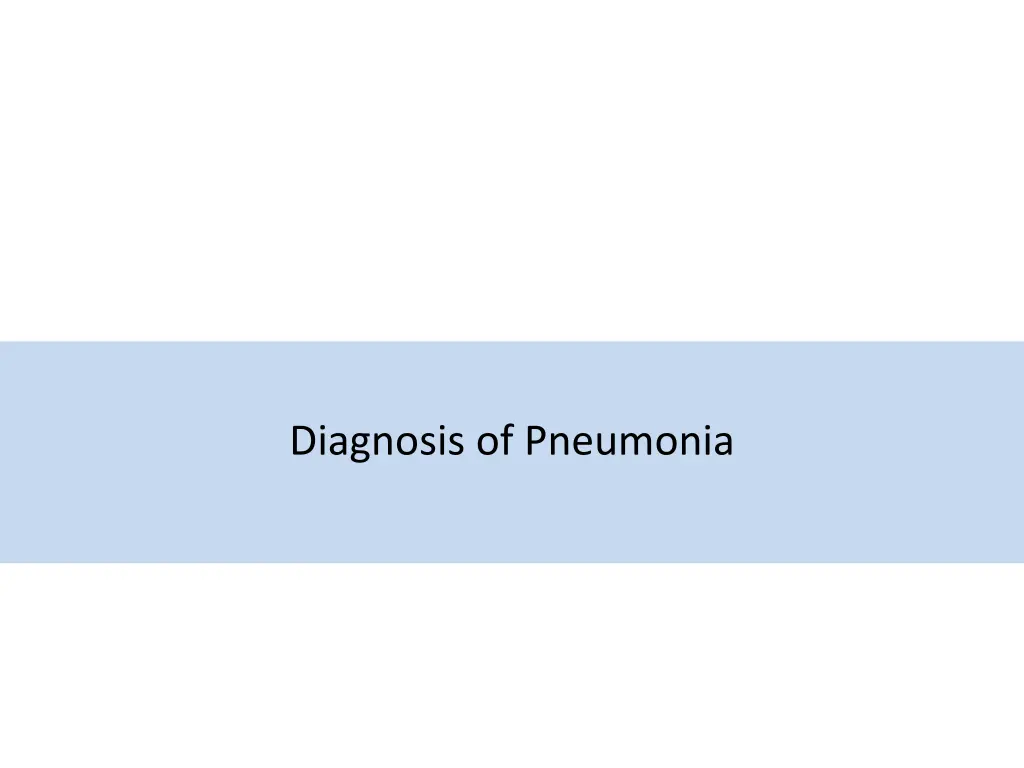
Understanding the Diagnosis and Investigations of Pneumonia
Learn about the essential diagnostic methods and investigations used for community-acquired pneumonia, including radiological and microbiological assessments. Discover how to differentiate pneumonia from other conditions, assess severity, and identify complications. Find out the significance of radiological findings, microbiological tests, and other investigations in managing pneumonia effectively.
Download Presentation

Please find below an Image/Link to download the presentation.
The content on the website is provided AS IS for your information and personal use only. It may not be sold, licensed, or shared on other websites without obtaining consent from the author. If you encounter any issues during the download, it is possible that the publisher has removed the file from their server.
You are allowed to download the files provided on this website for personal or commercial use, subject to the condition that they are used lawfully. All files are the property of their respective owners.
The content on the website is provided AS IS for your information and personal use only. It may not be sold, licensed, or shared on other websites without obtaining consent from the author.
E N D
Presentation Transcript
Investigations of community acquired pneumonia The objectives are to: Exclude other conditions that mimic pneumonia Identify the development of complications Assess the severity
Radiological investigations in patients with CAP In bronchopneumonia patchy non homogenous mostly basal opacity, while in lobar pneumonia, a homogeneous opacity localised to the affected lobe or segment usually appears within 12-18 hours of the onset of the illness. Clinical-radiographic dissociation is seen often in patients with Mycoplasma pneumoniae or viral pneumonia. Chest radiographs of patients with Mycoplasma infection often suggest a more serious infection than does the appearance of the patient or the physical examination. The converse is true in patients with Pneumocystis carinii infection, who may appear quite ill despite normal or nearly normal chest radiographs. This may also be true early in the course of acute bacterial pneumonias, when pleuritic chest pain, cough, purulent sputum, and inspiratory crackles may precede specific radiographic findings by many hours. when the patient's symptoms and signs point to this diagnosis. A "negative" radiograph can never rule out the possibility of acute bacterial pneumonia Although the pattern of infiltration may establish a specific microbiologic etiology, chest films are most useful for providing essential information on the distribution and extent of involvement,as well as potential pneumonic complications like para-pneumonic effusion Standard posteroanterior and lateral chest radiography are mandatory .
C A B D
Microbiological investigations in patients with CAP All patients Sputum: direct smear by Gram and Ziehl-Neelsen stains. Culture and antimicrobial sensitivity testing Blood culture: frequently positive in pneumococcal pneumonia Serology: acute and convalescent titres for Mycoplasma, Legionella, and viral infections. Pneumococcal antigen detection in serum or urine PCR: Mycoplasma can be detected from swab of oropharynx Severe community-acquired pneumonia .. .. .. . Follow Curb-65 scoring of severity The above tests plus consider: Tracheal aspirate, induced sputum, bronchoscopy or percutaneous needle aspiration. Serology: Legionella antigen in urine. Pneumococcal antigen in sputum and blood. Immediate IgM for Mycoplasma Cold agglutinins: positive in 50% of patients with Mycoplasma For selected patients Pleural fluid: should always be sampled when present in more than trivial amounts, preferably with ultrasound guidance
Other investigations Provides a non-invasive method of measuring arterial oxygen saturation (SaO2) and monitoring response to oxygen therapy. Pulse oximetry Is important in those with SaO2 < 93% or with features of severe pneumonia, to identify ventilatory failure or acidosis. Arterial blood gas May be normal or only marginally raised in pneumonia caused by atypical organisms, a neutrophil leucocytosis of more than 15 109/L favours a bacterial aetiology. The white cell count Urea and electrolytes And liver function tests should also be checked. C-reactive protein (CRP) Is typically elevated. Should be considered in every patient with confusional state to exclude disseminated infection into CNS CSF analysis
Exclude other conditions that mimic pneumonia Differential diagnosis of pneumonia mimic pneumonia cryptogenic organising pneumonia/bronchiolitis obliterans organising pneumonia (COP/BOOP) Pulmonary infarction Pulmonary/pleural TB Pulmonary oedema (can be unilateral) Pulmonary eosinophilia Malignancy: bronchoalveolar cell carcinoma Rare disorders:
Assess the severity Assessment of disease severity The CURB-65 scoring system helps guide antibiotic and admission policies, and gives useful prognostic information .
Identify the development of complications Complications of pneumonia Para-pneumonic effusion Empyema Retention of sputum causing lobar collapse DVT and pulmonary embolism Pneumothorax, particularly with Staph. aureus Suppurative pneumonia/lung abscess ARDS, renal failure, multi-organ failure Ectopic abscess formation (Staph. aureus) Hepatitis, pericarditis, myocarditis, meningoencephalitis Pyrexia due to drug hypersensitivity
Management Many cases of CAP can be managed successfully without identification of the organism, particularly if there are no features indicating severe disease. A full range of microbiological tests should be performed on patients with severe CAP . 1-oxygenation, 2-fluid balance 3-antibiotic therapy. 4-In severe or prolonged illness, nutritional support may be required. The most important aspects of management include
Oxygen Should be administered to all patients with tachypnoea, hypoxaemia, hypotension or acidosis with the aim of maintaining the PaO2 8 kPa (60 mmHg) or SaO2 92%. High concentrations ( 35%), preferably humidified, should be used in all patients who do not have hypercapnia associated with COPD. Assisted ventilation should be considered at an early stage in those who remain hypoxaemic despite adequate oxygen therapy. NIV may have a limited role but early recourse to mechanical ventilation is often more appropriate Intravenous fluids Should be considered in those with severe illness, in older patients and in those with vomiting. Otherwise, an adequate oral intake of fluid should be encouraged. Inotropic support may be required in patients with circulatory shock .
Antibiotic treatment The initial choice of antibiotic is guided by clinical context. In most patients with uncomplicated pneumonia a 7-10-day course is adequate, although treatment is usually required for longer in patients with Legionella, staphylococcal or Klebsiella pneumonia. Oral antibiotics are usually adequate unless the patient has severe illness, impaired consciousness, loss of swallowing reflex or malabsorption. Uncomplicated CAP Amoxicillin 500 mg 8-hourly orally or Clarithromycin 500 mg 12-hourly orally If Staphylococcus is cultured or suspected Flucloxacillin 1-2 g 6-hourly i.v. ....plus Clarithromycin 500 mg 12-hourly i.v. If Mycoplasma or Legionella is suspected Clarithromycin 500 mg 12-hourly orally or i.v. plus ..Rifampicin 600 mg 12-hourly i.v. in severe cases Clarithromycin 500 mg 12-hourly i.v. or Erythromycin 500 mg 6-hourly i.v. plus Co-amoxiclav 1.2 g 8-hourly i.v. or Ceftriaxone 1-2 g daily i.v. or Cefuroxime 1.5 g 8-hourly i.v. or Amoxicillin 1 g 6-hourly i.v. plus flucloxacillin 2 g 6-hourly i.v. Severe CAP
Treatment of pleural pain It is important, in order to allow the patient to breathe normally and cough efficiently. For the majority, simple analgesia with paracetamol or NSAIDs is sufficient. In some patients, opiates may be required but these must be used with extreme caution in patients with poor respiratory function. Physiotherapy may be helpful to assist expectoration in patients who suppress cough because of pleural pain or when mucus plugging leads to bronchial collapse. Indications for referral to ITU CURB score 4-5 failing to respond rapidly to initial management Persisting hypoxia (PaO2 < 8 kPa (60 mmHg)) despite high concentrations of oxygen Progressive hypercapnia Severe acidosis Circulatory shock Reduced conscious level
Prognosis Most patients respond promptly to antibiotic therapy. However, fever may persist for several days and the chest X-ray often takes several weeks or even months to resolve, especially in old age. Delayed recovery suggests either that a complication has occurred. or that the diagnosis is incorrect. Alternatively, the pneumonia may be secondary to a proximal bronchial obstruction or recurrent aspiration. The mortality rate in adults managed at home is very low (< 1%); hospital death rates are typically between 5 and 10%, but may be as high as 50% in severe illness. Discharge and follow-up The decision to discharge a patient depends on home circumstances and the likelihood of complications. A chest X-ray need not be repeated before discharge in those making a satisfactory clinical recovery. Clinical review should be arranged around 6 weeks later and a chest X-ray obtained if there are persistent symptoms, physical signs or reasons to suspect underlying malignancy.
Prevention The risk of further pneumonia is increased by smoking, so current smokers should be advised to stop. Influenza and pneumococcal vaccination should be considered in selected patients In developing countries, tackling malnourishment, indoor air pollution, and encouraging immunisation against measles, pertussis and Haemophilus influenzae type b are particularly important in children.


